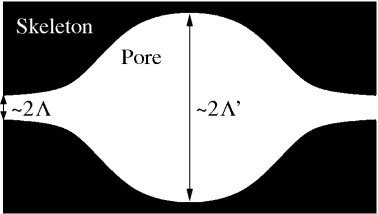For an usual porous material composed with pores and inter-connections between these pores, viscous effects mainly occur at the inter-connections (i.e. the smallest areas for the sound wave (P2) to propage through). From its definition the viscous characteristic length is thus found to be close to the value of the radius (or hydraulic radius) of the inter-connections between except for small values of the hydraulic radius of inter-connections as the viscous boundary layer will noticeably modify the flow velocity in the interconnections between pores in almost all the audible frequency range.
For usual acoustical materials the value of the viscous characteristic length lies in the range [11 - 350] micro-meters (see the page on the viscous boundary layer definition for a development leading to this statement).
For some specific porous morphologies, the parameters describing the visco-inertial dissipation are not independent. In the case of pores represented with non-intersecting identical tubes, of radius $R$, canted at a same angle $\theta$, the static air-flow resistivity $\sigma$ is calculated as $8\eta/[\phi R^2\cos^2(\theta))]$, the low frequency limit the the dynamic tortuosity $\alpha_\infty$ is equal to $1/\cos^2(\theta)$ and the viscous characteristic length $\Lambda$ is equal to $R$.
This computation lead some authors (among which Johnson, Koplik and Dashen) "to expect the parameters to be related to each other, at least approximately" for usual porous materials (i.e. without noticeable pore roughness) with:
\[
\Lambda = \sqrt{\displaystyle\frac{8\alpha_\infty k_0}{\phi}}
\]
This last expression corresponds to a viscous shape factor $M$ equal to 1.
A computation for slit-like pores, the relation between these visco-inertial parameters is found to be:
\[
\Lambda = \sqrt{\displaystyle\frac{12\alpha_\infty k_0}{\phi}}
\]
The viscous characteristic length can be estimated
from standing wave tube measurements or ultrasound techniques.
